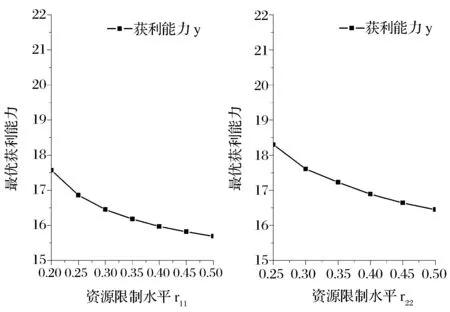基于动态控制模型的产学研知识转移合作博弈研究
吴 洁, 彭星星,盛永祥,李 鹏,施琴芬
(1.江苏科技大学经济管理学院,江苏 镇江 212003;2.南京邮电大学科技处,江苏 南京 210003)
基于动态控制模型的产学研知识转移合作博弈研究
吴 洁1, 彭星星1,盛永祥1,李 鹏1,施琴芬2
(1.江苏科技大学经济管理学院,江苏 镇江 212003;2.南京邮电大学科技处,江苏 南京 210003)
运用博弈论研究产学研合作中的知识转移问题,构建产学研知识转移动态控制模型,计算高校和企业在合作博弈状态下获取最大收益时的纳什均衡投入和最优获利能力,分析资源限制水平、共生作用系数变动下纳什均衡投入和最优获利能力的变化情况。模拟分析表明,高校和企业可以根据系统内的知识产出量和吸收量来调整对知识产出和知识吸收的控制投入,从而影响产学研的最优获利能力;提高共生作用系数或降低资源限制水平均可降低产学研的纳什均衡投入,提高其最优获利能力。
知识转移;产学研合作;动态控制模型;合作博弈
1 引言
加快建立以企业为主体、市场为导向、产学研相结合的技术创新体系是提高国家自主创新能力的重要途径[1]。高校与企业之间的合作创新能够使双方获得资金上的增加,并且可以作为经济增长的引擎[2]。产学研合作创新实质上是合作各方知识转移的过程[3],以促进知识增值从而实现知识向现实生产力的转化。知识转移的增值成为产学研合作成功的关键[4]。
知识转移的双方都希望从知识转移中得到战略收益以及经济收益[5],为了获得更大收益,转移双方会倾向于做出对自身更有利的行为。因此,知识转移的过程也是转移双方在内容、方式等方面博弈的过程[6]。现有的研究从多个角度分析了知识转移的博弈情况,如Lin Lihui等[7]借助博弈论中的信号博弈模型来描述知识转移过程;李洋[8]等构建激励下的演化博弈模型,研究博弈主体知识转移过程中的努力投入演化情况;Jiang Zhangsheng[9]等构建了技术创新联盟内知识转移博弈的两阶段模型,分析了不同所有权和学习能力情况下联盟的稳定性;Li和Li[10]运用博弈方法分析实践社群知识共享的激励机制,发现若高知识共享效率实践社群比低知识共享效率实践社群的共享成本低,则完全信息条件和不完全信息条件下的实践社群知识共享效益相同。Bandyopadhyay[11]等建立的外包项目中知识共享的博弈模型,分析了不同知识水平下知识共享双方的最高收益。Szulanski[12]等考虑到知识转移的时间选择,在前期转移和后期转移两种模式下分析最优知识转移方法,提出知识转移难度由转移知识的因果模糊性及知识转移双方关系决定。国内研究最多的是知识转移的策略,即转移主体根据对合作对方行为的判断决定是“转移”还是“不转移”,如许学国等[13]根据生物回升模型模拟企业间知识转移主体的行为,构建知识转移行为的动态演化博弈模型;蒋樟生等[14]建立了技术创新联盟知识转移决策的主从博弈模型,指出联盟存在和发展的前提条件是盟主企业的知识边际收益足够大;董广茂等[15]构建知识转移博弈模型,分析竞争条件下知识转移战略及决定因素;陈果等[16]考虑只是发送方的风险态度为私有信息,利用演化博弈分析知识发送方风险态度披露策略和知识接收方信息处理策略的演化均衡,以及对知识转移的影响。
总结国内外研究文献发现,学者们多从宏观的角度出发,分析如何通过知识转移策略的选择实现知识转移收益最大化,但很少深入探究合作双方具体怎样控制自身的知识转移投入才能获得最大收益。
知识转移是一个动态的过程,因而转移双方如何根据需要实现对知识转移投入的动态控制显得尤为重要。目前动态控制已被学者们应用于多领域的研究[18-31],但在知识转移方面还鲜有涉及。Haurie等[17]学者构建了两生物种群的动态控制冲突模型,通过改变控制变量影响双方的生物捕获量,解决生物种群的捕获收益问题。组织知识的演化具有明显的生态系统特征。在产学研合作中,高校和企业则可以通过改变知识转移投入影响双方的知识转移量,解决产学研知识转移的收益问题。
因此。本文借鉴已有的知识转移相关研究成果,结合产学研合作的特点,在Haur等学者[17]动态控制冲突模型的基础上,建立产学研合作中的知识转移动态控制模型。与以往研究不同之处,本文尝试将动态控制的思想引入到产学研知识转移中,并定量分析高校和企业调节知识转移控制投入以持续获取最大收益的不同路径,为产学研知识转移提供理论借鉴。
2 模型构建
2.1 基本假设
假设1:某高校和企业同属于一个产学研合作系统,高校是知识的输出方,企业是知识的接收方。在t时刻,高校的知识产出量为x1(t),企业的知识吸收量为x2(t)。
假设2:高校知识产出量的自然增长率为ε1,企业知识吸收量的自然增长率为ε2,二者都是在没有外界环境制约下各主体内部行为引起的变化。
假设3:高校的知识产出量受到知识产出基础设施、知识水平、知识转移能力等资源的制约,不可能无限增大,因此假设其受到的资源限制水平为r11。同理,企业的知识吸收量受到知识吸收基础设施、知识吸收能力等资源的制约,记企业的资源限制水平为r22。
假设4:由于同处于一个产学研合作系统,作为知识产出方的高校和作为知识吸收方的企业组成了知识转移的链条,这种链条形成了高校和企业间相互补充、相互促进的共生关系。高校和企业之间合作的契合度、交流的频繁度等都会影响双方的共生关系。记企业对高校的共生作用系数为r21,高校对企业的共生作用系数为r12。
假设5:高校可以通过控制对知识产出的投入来控制自身的知识产出量,也可以通过控制对知识转移的投入来影响企业的知识吸收量。记高校对知识产出的控制投入为u1,它是高校对自身知识产出的控制变量;记高校对知识转移的控制投入为u2,它是高校对企业知识吸收的控制变量。
假设6:作为产学研合作主体,高校产出知识需要企业的资助,所以企业可以通过控制对高校的投入来控制高校的知识产出量。同时,企业吸收知识也需要一定的投入,企业可以通过控制对知识吸收的投入来控制自身的知识吸收量。记企业对高校知识产出的控制投入为v1,它是企业对高校知识产出的控制变量;记企业对知识吸收的控制投入为v2,它是企业对自身知识吸收的控制变量。
2.2 知识转移动态控制模型建立
根据以上假设建立产学研知识转移的动态控制模型为:
(1)


2.3 高校和企业目标函数计算

企业在此段时间所获取的目标收益合计为:
3 知识转移合作博弈求解
获得经济利益是产学研合作各方参与合作的主要动力与目的[19]。为了获得更大利益,高校和企业会采取联合的方式,使产学研合作系统中的资源得到最优配置,以谋求整体利益最大化,并在整体利益最大化的基础上进行利益分配,从而达到共赢。高校和企业通过调整各自的知识转移投入实现共赢的过程,也是双方合作博弈的过程。当高校和企业进行合作博弈时追求的是产学研合作整体利益最大化。
这时高校和企业选择的控制策略可以归结为一个标准:
P(u,v)=P1(u,v)+P2(u,v)

其中共轭变量λ1和λ2满足方程组:
(2)
边界条件λ1(T)=λ2(T)=0。
采用极大值原则解决这一问题时,双方优化控制的条件为:
由此得到优化控制的计算公式:
(3)
(4)
将得到优化控制的计算公式(3)、(4)带入动态控制模型(1)得到方程组:
(5)
其中λ1和λ2由(2)和(5)组成的下列微分方程组:
(6)
求得。初始—边界条件为:
不等式:
P(u*(t),v*(t))≥P(u(t),v(t))
对任何对手允许的程序控制成立。所以:
P(u*(t),v*(t))=P1(u*(t),v*(t))+P2(u*(t),v*(t))≥P1(u0(t),v0(t))+P2(u0(t),v0(t))
其中(u*(t),v*(t))是Nash均衡状态。将微分方程组(6)求得的解代入到(3)、(4)算出该Nash均衡态的值,即高校和企业获取最大整体利益时的纳什均衡投入。
4 仿真分析
4.1 初始参数设置


表1 仿真参数赋值
4.2 投入的影响


图1 投入随知识产出量和知识吸收量的变化关系


图2 最优获利能力随时间的变化关系
4.3 共生作用系数的影响


图3(a) 共生作用系数对总投入的影响

图3(b) 共生作用系数对获利能力的影响
4.3 资源限制水平的影响


图4(a) 资源限制水平对总投入的影响

图4(b) 资源限制水平对总投入的影响
5 结语
本文运用博弈论研究了产学研合作中的知识转移问题,并将高校和企业作为两个控制体,建立了产学研联盟中的知识转移动态控制模型,构造了高校和企业获取收益的目标函数。运用纳什均衡理论和哈密顿函数求得了高校和企业在合作博弈状态下获取最大收益时的纳什均衡投入,探究了纳什均衡投入与知识产出量和知识吸收量的关系及资源限制水平、共生系数变动下纳什均衡投入和单位投入最优获利能力的变化情况。模拟分析表明,高校和企业可以根据当前产学研合作系统内的知识产出量和吸收量来控制对知识产出和知识吸收的投入,从而影响产学研的最优获利能力;通过提高高校和企业间的共生作用或者降低资源限制水平均可降低产学研的纳什均衡投入,提高其利润获取能力。
鉴于此,高校和企业在产学研合作的过程中,应该根据当前合作系统中的知识产出量和吸收量随时调整控制投入,以保持产学研的获利能力在较高水平。另外,在产学研合作的过程中,高校和企业应建立广泛的联系,加强双方间的相互交流,提高双方间的合作默契度,从而充分利用双方间的共生影响作用。同时应提高自身学习能力、消化吸收能力,建立完善的知识转移基础设施,如技术和网络设施等,从而增强产学研合作的利润获取能力。
[1] 曹霞,刘国巍.基于社会资本的产学研合作创新超网络分析[J].管理评论,2013,25(4):115-124.
[2] Khan Z, Shenkar O, Lew Y K. Knowledge transfer from international joint ventures to local suppliers in a developing economy[J]. Journal of International Business Studies, 2015, 46(6):112.
[3] 刘芳.社会资本对产学研合作知识转移绩效影响的实证研究[J].研究与发展管理,2012,24(1):103-111.
[4] 曹霞,于娟,张路蓬.不同联盟规模下产学研联盟稳定性影响因素及演化研究[J].管理评论,2016,28(2):3-14.
[5] Lai J, Lui S S, Tsang E W K. Intrafirm knowledge transfer and employee innovative behavior: the role of total and balanced knowledge flows[J]. Journal of Product Innovation Management, 2015,33(1):90-103.
[6] 高丽坤,艾时钟.企业间知识转移的泄密问题研究[J].中国管理科学,2015,23(S1):364-369.
[7] Lin Lihui, Geng Xianjun, Whinston A B. A sender-receiver framework for knowledge transfer[J]. MIS quarterly, 2005,29(2): 197-219.
[8] 李洋,刘伟.基于演化博弈理论的软件隐形需求开发研究[J].系统管理学报,2015,24(4):480-495.
[9] Jiang Zhangsheng, Hao Yunhong. Game analysis of technology innovation alliance stability based on knowledge transfer [J]. Computational & Mathematical Organization Theory, 2013, 19(4):403-421.
[10] Li Y M,Li J H. Knowledge sharing in communities of practice: A game theoretic analysis [J]. European Journal of Operational Research, 2010, 207(2):1052-1064.
[11] Bandyopadhyay S, Pathak P.Knowledge sharing and cooperation in outsourcing projects——A game theoretic analysis[J]Decision Support Systems,2007,43 (2):349-358.
[12] Szulanski G, Ringov D, Jensen R J. Overcoming stickiness: How the timing of knowledge transfer methods affects transfer difficulty[J]. Organization Science, 2016, 27(2): 304-322.
[13] 许学国,梅冰青,吴耀威.跨国公司-代工企业知识转移主体行为研究[J].经济与管理研究,2016,37(4):119-126.
[14] 蒋樟生,胡珑瑛.技术创新联盟知识转移决策的主从博弈分析[J].科研管理,2012,33(4):41-47+61.
[15] 董广茂,林敏,雷宏振. 竞争条件下企业知识转移战略及其对产业演化的影响[J].管理学报,2014,11(8):1246-1252.
[16] 陈果,齐二石.风险态度不成对下的企业间知识转移研究[J].中国管理科学,2016,24(12):82-90.
[17] Haurie A, Krawczyk J. An introduction to dynamic games [M].2000.
[18] Chen K, Xiao Tiaojun. Ordering policy and coordination of a supply chain with two-period demand uncertainty[J]. European Journal of Operational Research, 2011, 215(2): 347-357.
[19] Hamdouch Y Multi-period supply chain network equilibrium with capacity constraints and purchasing strategies[J].Transportation Research, Part C, 2011, 19(5): 803-820.
[20] Dong F, Deglise-Hawkinson J R, Van Oyen M P, et al. Dynamic control of a closed two-stage queueing network for outfitting process in shipbuilding [J]. Computers & Operations Research,2016.72:1-11.
[21] Liu Zugang, Nagurney A. Multiperiod competitive supply chain networks with inventorying and a transportation network equilibrium reformulation [J].Optimization and Engineering, 2012, 13(2): 471-503.
[22] Venayak N, Anesiadia N, Cluett W R, et al. Engineering metabolism through dynamic control[J].Current Opinion in Biotechnology,2015,34:142-152.
[23] Antonelli M, Baccioli A, Francesconi M, et al. Dynamic modelling of a low-concentration solar power plant: A control strategy to improve flexibility [J]. Renewable Energy,2016.95:574-585.
[24] Su Zhilong, Li Xiaokang, Jiang Xuesong, et al. Dynamic control of the location of nanoparticles in hybrid co-assemblies[J]. Nanoscale, 2015, 7(12):5262-9.
[25] 黄孝鹏,周献中.复杂决策任务层级分解动态控制策略与算法[J].军事运筹与系程,2013,27(1): 71-75.
[26] 李恒,张友安,孙富春,等.多操纵面飞机全局集合稳定非线性自适应动态控制分配[J].控制与决 策,2013,28(3):379-390.
[27] 彭兰梅.施工进度计划的动态控制在高速公路改造工程中的应用[J].中外公路,2013,33(5):349-351.
[28] 谢文博,付明玉,施小成.一类非线性系统的加速度规划输出跟踪动态控制[J].控制理论与应用,2013,27(1):71-75.
[29] Huang Jiajiang, Liu Xin, Li Dan, et al. Dynamic control of enhancer repertoires drives lineage and stage-specific transcription during hematopoiesis[J]. Developmental cell, 2016, 36(1): 9-23.
[30] Ferrer P, Castillo-Neyra R, Roy C N, et al. Dynamic control of hepatic Plasmodium numbers by hepcidin despite elevated liver iron during iron supplementation[J]. Microbes and Infection, 2016, 18(1): 48-56.
[31] Kamimura M, Sugawara M, Yamamoto S, et al. Dynamic control of cell adhesion on a stiffness-tunable substrate for analyzing the mechanobiology of collective cell migration[J]. Biomaterials science, 2016, 4(6): 933-937.
Research on Knowledge Transfer Cooperative Game in University-Industry Cooperation Based on Dynamic Control Model
WU Jie1, PENG Xing-xing1, SHENG Yong-xiang1,LI Peng1,SHI Qin-fen2
(1.Economics & Management School, Jiangsu University of Science and Technology, Zhenjiang 212003,China;2.Office of Science & Technology, Nanjing University of Posts and Telecommunications, Nanjing 210003,China)
In the collaboration practice among industry, universities and research institutes, universities and enterprises can influence the amount of knowledge of both sides by changing the knowledge transfer input to resolve the problem of income among industry, universities and research institutes. Universities’ knowledge output and enterprises’ absorptive amount can be affected at time, natural growth rate, restriction level of resource, symbiotic relationship, partner’s behaviour and self behavior. In this paper, adjustments of knowledge transfer input for universities and enterprises to pursue their own maximum interest are analyzed through building dynamic control model. the objective function is calcucated, the equilibrium of cooperative game in knowledge transfer is solved and a simulation analysis in made. In this model, universities and enterprises are the control subjects. They pursue their own maximum interest by adjusting the investment of knowledge transfer. Based on the method of calculating the dynamic control model, the initial value of model parameter is gotten through the empirical research and makes a simulation. Simulation results show that universities and enterprises can adjust the investment according to the knowledge output and knowledge absorption in the system, and then affect the optimal profit ability of industry, universities and research institutes.The increase of the symbiotic effect coefficient and decrease of resource constraints levels is helpful to minimize the Nash equilibrium input and maximize the optimal profit ability. in view of this, In the process of "industry-university-institute" cooperation, universities and enterprises should adjust the investment at any time according to the knowledge output and knowledge absorption in the system to maintain production profitability at a higher level. In addition, in the process of "industry-university-institute" cooperation, universities and enterprises shall establish extensive connection, strengthen mutual exchanges between the two sides, improve the tacit understanding degree and make full use of the symbiotic effect between the two sides.
knowledge transfer; university-industry cooperation; dynamic control model; cooperative game
1003-207(2017)03-0190-07
10.16381/j.cnki.issn1003-207x.2017.03.022
2015-05-28;
2016-05-21
国家社科基金重点资助项目(14AGL001);国家自然科学基金资助项目(71271119,71401064,71471091)
吴洁(1968-),女(汉族),江苏滨海人,江苏科技大学经济管理学院,教授,研究方向:知识转移、技术创新,E-mail:0511wujie@163.com.
F224.32;F272
A

